Link to video footage: here
Before any of you get smart, yes I had noticed there isn't an S on the front grille, but I thought you may benefit from the knowledge that this product will fit your car (there is an identical kit currently running on Revotechnik's Leon Cupra RT360). Whilst their car has been reviewed recently, to date the filter in isolation has not been reviewed in any level of detail.
You have a Carbonio, why change for an ITG?
So before I begin let me fill you in as to my choice. I'd been needing a kit for a while, and had been awaiting the Twintake from Forge for some time. My lease on the S3 is running out fast, therefore time is of the essence. Yes, I ran a Carbonia intake / filter which whilst at stage 1 was perfectly satisfactory, however since fitting the HPFP & Revo Stg2+ map there was a slightly flat sensation when accelerating from mid speeds. There were 3 likely candidates: Intake / DP / Cats. From a considered review of previous experience mixed with the opinions of people I respect, I decided to sort the filter first as logs had shown I was lacking air at the MAF, and to be honest exhausts are just overrated and horribly expensive.
So who are ITG?
I was introduced to Andy Jackson at ITG by RevoCarl, and got chatting as to the merits of their CAI system. I had always believed ITG to be a company that made filters for race vehicles rather than road cars, and it turns out ITG's client base is actually extensive on and off the track (Vauxhall VXR BTCC / Renault F1 / Red Bull Racing to name a few of the ones you'd instantly recognise).
So what is there solution?
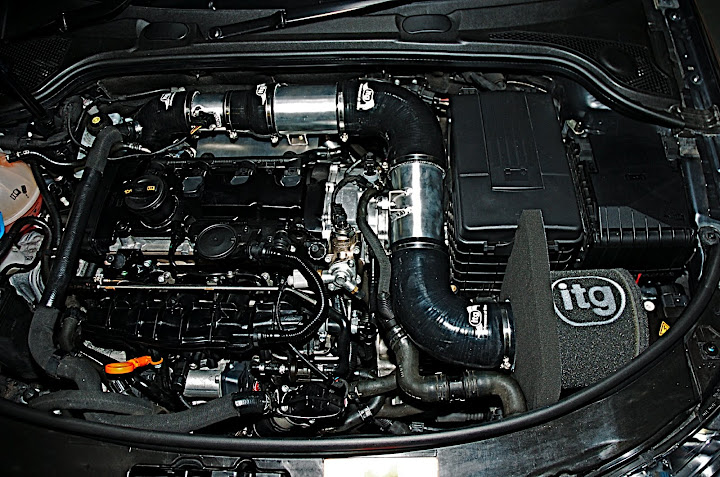
This is the end product. See the girth on those pipes?! See the quality of the finish? See how tight the filter fits in the enclosure?! (Don't worry, this is an S3 affliction, and the Leon has far more space for the filter!). There will be some of you scratching your head now, wondering why this kit doesn't look like an Evoms, Forge or a Dbilas, with fancy logo'd enclosures. I will address these questions later, so stay with me for the 'science part' later on. I will be the first to admit, if bling is your primary concern you will find this system slightly 'functional' and lacking in glam. However, look closely and there is some VERY industrial and clever engineering, and as you will see in later photos an incredible level of attention to detail.
So what does it offer over and above OEM?
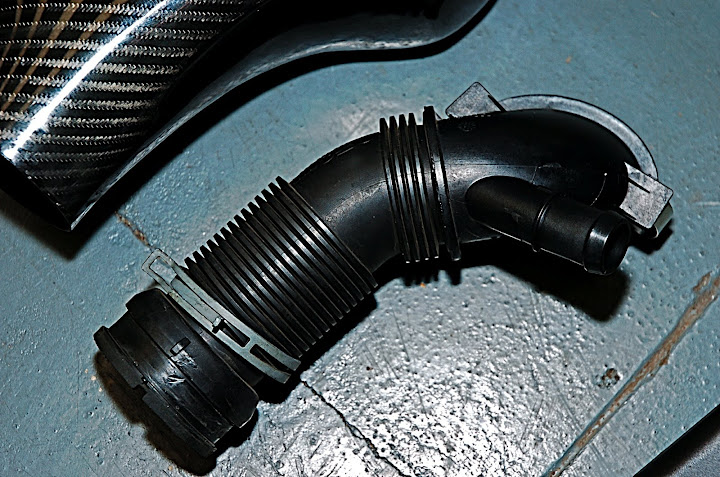
See the plastic pipe above. That is the pipe that disappears down the back offside of the engine from the MAF. Getting the spring clip of this baby requires some patience and a rather funky tool, but as you can see it is not the most efficient pipe on earth.
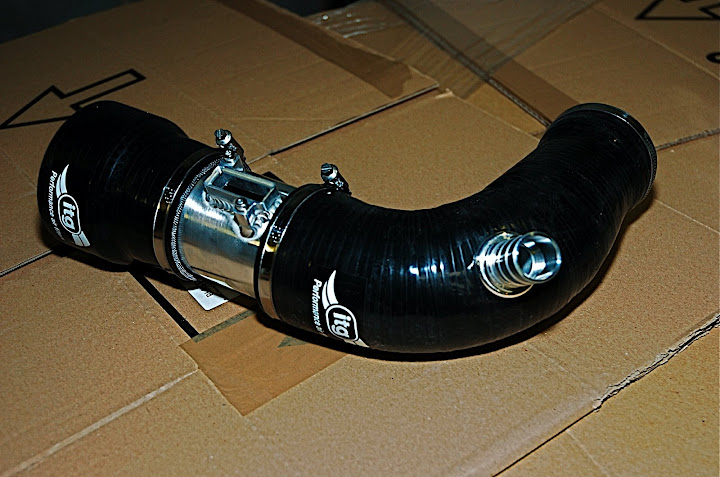
Above is the ITG replacement. It is less restrictive than the OEM unit without the concertina effect, and is made out of robust silicone hosing. The piping diameter up past the MAF has to be consistent with OEM equipment (67mm I seem to remember) to ensure the MAF reads as it would in the OEM pipework (to keep the ECU reading accurately). The MAF connector pipe connects to this pipe (the alloy section to the left), and there is a beautifully crafted cut out which seats the MAF precisely. Another piece of silicone hose connects to this (furthest left), at which point the pipework expands out (can't remember if this is 89mm).
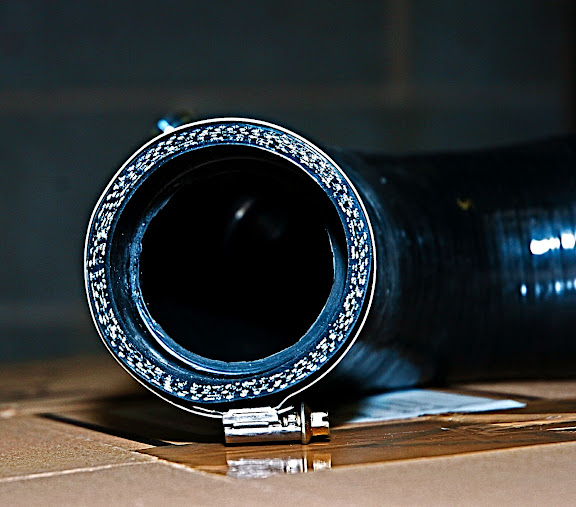
If you look inside the down pipe (goes down the back of the engine), you can see they have even bothered to chamfer the hose just like the original to ensure the air flow isn't constantly disrupted by steps inside the flow path.
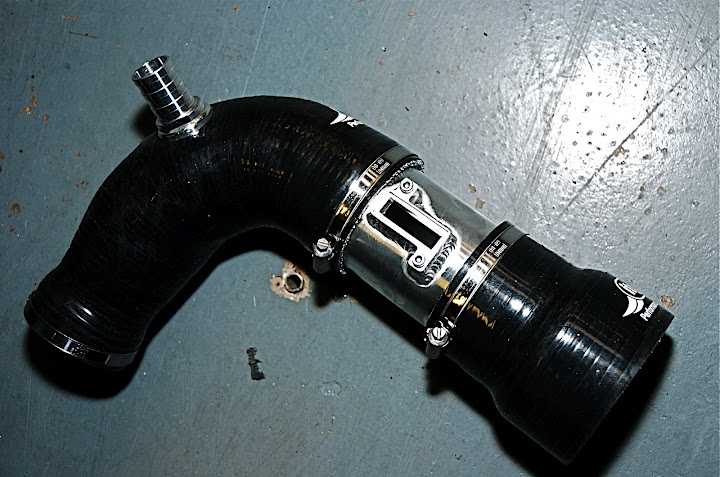
The pipework has been maximised in diameter for good reason. This intake has quite a long flow path from the filter through to the business end, and with 3 right angles also in the flow path it actually benefits airflow through the bends to increase the diameter of the pipework a little (or so I am told). I don't understand the dynamics of airflow so I won't embarrass myself, but Andy has years of experience and the results speak for themselves so I will leave that point there. A result of using enlarged diameter pipework (in conjunction with a large filter surface area and type of material used), the turbo spools up so (and when I say so I actually mean SO) much faster. I'll be honest, I wasn't expecting that much from a CAI, however I had underestimated the restrictive nature of the OEM box I've been using. Whilst it served a purpose to keep the Audi service techs heart rates in the normal range, it was nothing but a blocker in stage 2 trim.
The compromise
In a perfect world, as Andy is passionate about quality, he would have loved me to have either relocated the battery, or replaced it with a slim line one (Audi TT's have this privilege bestowed upon them from factory. If so we could have fitted one of these babies:

However, this is a compromise from a cost and convenience perspective I could not commit to. Big turbo cars would benefit from considering this as the filter would be able to flow well in excess of 400bhp due to its increased size. The one in the pictures is good for over 360bhp which mirrors closely with Revo's stage 2+ pack.
This was not to be, so a conventional barrel filter was fitted with a surface area which closely mirrors that of an OEM paper filter. Due to the maths, the surface area of the filter can significantly increase/decrease the capacity to produce BHP in turbocharged cars, and although Andy did furnish me with the equation for this for the ITG foam and how it's BHP capabilities per cm2 area change I have to profess I have forgotten them
It's quite a tight fit in the S3 as the adaptive bi-xenons are incredibly deep, and the rounded edge nature of the car further removes space. The Leon has the best space, followed by the Golf, Octavia and then S3
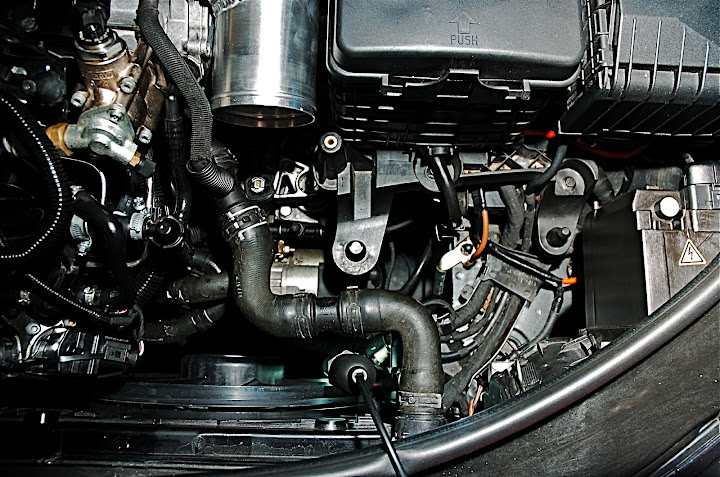
Althoug this kit is currently in prototype form, it has advanced significantly from the previous 2 iterations, and now includes very solid mounting points, a decent rear heat shield to deflect heat from the exhaust, and enough give in the silicone hoses to ensure the MAF is protected from any significant vibration.
The filter enclosure
ITG have researched this parameter of the CAI in some detail, and have looked at various materials to take charge of creating a defined enclosure for this open filter. After much trial and error they have used a foam baffle, and this makes sense for many reasons. Firstly ITG foam is fireproof, so can deal with a great deal of heat. Secondly foam expands into almost any gaps, and by using light to test for breaches round the foam wall they have been able to produce an enclosure which only suffers a few degrees increase from ambient (this has been tested). So now your thinking, foam lets air through, so that means engine air can get into the enclosure. Yes it can, but due to the pressure of air coming in around the headlight and inner wing there is equalisation which holds this air back. Whilst we're on the subject of heat, being the honest and open minded reviewer I try to be, the alloy pipework in the main bay can get very hot. To reduce the price of the kit to a decent RRP (due very soon), they have elected not to include elaborate heat insulation jackets/tape for the pipework. You can get this from Agriemach or other motorsport suppliers if you find you want it (circa £60).

So the foam goes in and the kit is finished. Not a supermodel in the world of CAI's but certainly a titan of excess engineering.
On the road
Once all the bolts were done up, the MAF transferred in, and the foam adjusted to hug the bonnet lid we were ready to roll.
What I found initially impressive is that I was wondering whether this excess would lead to any odd side effects. I'm pleased to announce all was as should be, and other than a bit of gentle metallic rasp it was as OEM as you could wish it to sound pootling around town.
Out of town matters took a turn, and this intake rasps....loud. Between gear changes you get a chatter from the DV as the pressures equalize out, and the surge of acceleration is; well relentless. Gone (completely) was the flat spot at 4k, and the car surged hard to 7200rpm, gear after gear. Quite literally a transformation, and one that forced me to apologise to Andy as I'd doubted that his efforts would have transformed the car quite so much. Remember here I am comparing to the OEM engine cover unit, NOT another CAI, but I would reckon that whilst there is way in excess of 10bhp improvement, its actually the torques that have benefitted the most.
I'm confused - this is not a placebo effect. How does it work?
My old intake connected to the slam panel to take air in. A very noble cause, and it makes common sense. However the size of the inlet aperture is quite small and restrictive. We tapped a large opening from behind the nearside fog light, and another point behind the nearside headlight to get airflow feeding the foam baffled enclosure and it provided a far more plentiful supply of air than was getting past the mouth of the Carbonio. This in tandem with the large diameter pipework and large filter increase the spooling capacity of the turbo therefore delivering multiple benefits.
Should I buy one?
It's the common practice of anyone who buys anything to tell everyone they should sell a vital organ to get one. I guess my summation is this. If you value performance above aesthetics this is a great solution. I actually warmed to the look of this once I'd had the chance to acquaint myself with the attention to detail, but even it's maker admits its not beautiful. Purposeful, yes. I think Andy appreciated my open minded perspective on this attribute, as it would be easy for an Audiman to value looks over performance. Pricewise it is going to sit right in the main ground at circa £300 (subject to kit finalisation). This is an incredibly fair price for the benefits. If you ever have plans to go BT, this kit offers a stage 2 perspective by moving/changing the battery and go way beyond 400bhp capability so has similar flexibility to the Revo staged kit. It's no surprise that as Revo use it, it has been extensively tested with this unit, so works an absolute treat together.
When is it out
About a month for finalised production versions. To register interest please contact Andy Jackson at ITG, or for more detail on ITG products visit the ITG website here.
Any questions? Fire away.
Before any of you get smart, yes I had noticed there isn't an S on the front grille, but I thought you may benefit from the knowledge that this product will fit your car (there is an identical kit currently running on Revotechnik's Leon Cupra RT360). Whilst their car has been reviewed recently, to date the filter in isolation has not been reviewed in any level of detail.
You have a Carbonio, why change for an ITG?
So before I begin let me fill you in as to my choice. I'd been needing a kit for a while, and had been awaiting the Twintake from Forge for some time. My lease on the S3 is running out fast, therefore time is of the essence. Yes, I ran a Carbonia intake / filter which whilst at stage 1 was perfectly satisfactory, however since fitting the HPFP & Revo Stg2+ map there was a slightly flat sensation when accelerating from mid speeds. There were 3 likely candidates: Intake / DP / Cats. From a considered review of previous experience mixed with the opinions of people I respect, I decided to sort the filter first as logs had shown I was lacking air at the MAF, and to be honest exhausts are just overrated and horribly expensive.
So who are ITG?
I was introduced to Andy Jackson at ITG by RevoCarl, and got chatting as to the merits of their CAI system. I had always believed ITG to be a company that made filters for race vehicles rather than road cars, and it turns out ITG's client base is actually extensive on and off the track (Vauxhall VXR BTCC / Renault F1 / Red Bull Racing to name a few of the ones you'd instantly recognise).
So what is there solution?
This is the end product. See the girth on those pipes?! See the quality of the finish? See how tight the filter fits in the enclosure?! (Don't worry, this is an S3 affliction, and the Leon has far more space for the filter!). There will be some of you scratching your head now, wondering why this kit doesn't look like an Evoms, Forge or a Dbilas, with fancy logo'd enclosures. I will address these questions later, so stay with me for the 'science part' later on. I will be the first to admit, if bling is your primary concern you will find this system slightly 'functional' and lacking in glam. However, look closely and there is some VERY industrial and clever engineering, and as you will see in later photos an incredible level of attention to detail.
So what does it offer over and above OEM?
See the plastic pipe above. That is the pipe that disappears down the back offside of the engine from the MAF. Getting the spring clip of this baby requires some patience and a rather funky tool, but as you can see it is not the most efficient pipe on earth.
Above is the ITG replacement. It is less restrictive than the OEM unit without the concertina effect, and is made out of robust silicone hosing. The piping diameter up past the MAF has to be consistent with OEM equipment (67mm I seem to remember) to ensure the MAF reads as it would in the OEM pipework (to keep the ECU reading accurately). The MAF connector pipe connects to this pipe (the alloy section to the left), and there is a beautifully crafted cut out which seats the MAF precisely. Another piece of silicone hose connects to this (furthest left), at which point the pipework expands out (can't remember if this is 89mm).
If you look inside the down pipe (goes down the back of the engine), you can see they have even bothered to chamfer the hose just like the original to ensure the air flow isn't constantly disrupted by steps inside the flow path.
The pipework has been maximised in diameter for good reason. This intake has quite a long flow path from the filter through to the business end, and with 3 right angles also in the flow path it actually benefits airflow through the bends to increase the diameter of the pipework a little (or so I am told). I don't understand the dynamics of airflow so I won't embarrass myself, but Andy has years of experience and the results speak for themselves so I will leave that point there. A result of using enlarged diameter pipework (in conjunction with a large filter surface area and type of material used), the turbo spools up so (and when I say so I actually mean SO) much faster. I'll be honest, I wasn't expecting that much from a CAI, however I had underestimated the restrictive nature of the OEM box I've been using. Whilst it served a purpose to keep the Audi service techs heart rates in the normal range, it was nothing but a blocker in stage 2 trim.
The compromise
In a perfect world, as Andy is passionate about quality, he would have loved me to have either relocated the battery, or replaced it with a slim line one (Audi TT's have this privilege bestowed upon them from factory. If so we could have fitted one of these babies:
However, this is a compromise from a cost and convenience perspective I could not commit to. Big turbo cars would benefit from considering this as the filter would be able to flow well in excess of 400bhp due to its increased size. The one in the pictures is good for over 360bhp which mirrors closely with Revo's stage 2+ pack.
This was not to be, so a conventional barrel filter was fitted with a surface area which closely mirrors that of an OEM paper filter. Due to the maths, the surface area of the filter can significantly increase/decrease the capacity to produce BHP in turbocharged cars, and although Andy did furnish me with the equation for this for the ITG foam and how it's BHP capabilities per cm2 area change I have to profess I have forgotten them

It's quite a tight fit in the S3 as the adaptive bi-xenons are incredibly deep, and the rounded edge nature of the car further removes space. The Leon has the best space, followed by the Golf, Octavia and then S3
Althoug this kit is currently in prototype form, it has advanced significantly from the previous 2 iterations, and now includes very solid mounting points, a decent rear heat shield to deflect heat from the exhaust, and enough give in the silicone hoses to ensure the MAF is protected from any significant vibration.
The filter enclosure
ITG have researched this parameter of the CAI in some detail, and have looked at various materials to take charge of creating a defined enclosure for this open filter. After much trial and error they have used a foam baffle, and this makes sense for many reasons. Firstly ITG foam is fireproof, so can deal with a great deal of heat. Secondly foam expands into almost any gaps, and by using light to test for breaches round the foam wall they have been able to produce an enclosure which only suffers a few degrees increase from ambient (this has been tested). So now your thinking, foam lets air through, so that means engine air can get into the enclosure. Yes it can, but due to the pressure of air coming in around the headlight and inner wing there is equalisation which holds this air back. Whilst we're on the subject of heat, being the honest and open minded reviewer I try to be, the alloy pipework in the main bay can get very hot. To reduce the price of the kit to a decent RRP (due very soon), they have elected not to include elaborate heat insulation jackets/tape for the pipework. You can get this from Agriemach or other motorsport suppliers if you find you want it (circa £60).
So the foam goes in and the kit is finished. Not a supermodel in the world of CAI's but certainly a titan of excess engineering.
On the road
Once all the bolts were done up, the MAF transferred in, and the foam adjusted to hug the bonnet lid we were ready to roll.
What I found initially impressive is that I was wondering whether this excess would lead to any odd side effects. I'm pleased to announce all was as should be, and other than a bit of gentle metallic rasp it was as OEM as you could wish it to sound pootling around town.
Out of town matters took a turn, and this intake rasps....loud. Between gear changes you get a chatter from the DV as the pressures equalize out, and the surge of acceleration is; well relentless. Gone (completely) was the flat spot at 4k, and the car surged hard to 7200rpm, gear after gear. Quite literally a transformation, and one that forced me to apologise to Andy as I'd doubted that his efforts would have transformed the car quite so much. Remember here I am comparing to the OEM engine cover unit, NOT another CAI, but I would reckon that whilst there is way in excess of 10bhp improvement, its actually the torques that have benefitted the most.
I'm confused - this is not a placebo effect. How does it work?
My old intake connected to the slam panel to take air in. A very noble cause, and it makes common sense. However the size of the inlet aperture is quite small and restrictive. We tapped a large opening from behind the nearside fog light, and another point behind the nearside headlight to get airflow feeding the foam baffled enclosure and it provided a far more plentiful supply of air than was getting past the mouth of the Carbonio. This in tandem with the large diameter pipework and large filter increase the spooling capacity of the turbo therefore delivering multiple benefits.
Should I buy one?
It's the common practice of anyone who buys anything to tell everyone they should sell a vital organ to get one. I guess my summation is this. If you value performance above aesthetics this is a great solution. I actually warmed to the look of this once I'd had the chance to acquaint myself with the attention to detail, but even it's maker admits its not beautiful. Purposeful, yes. I think Andy appreciated my open minded perspective on this attribute, as it would be easy for an Audiman to value looks over performance. Pricewise it is going to sit right in the main ground at circa £300 (subject to kit finalisation). This is an incredibly fair price for the benefits. If you ever have plans to go BT, this kit offers a stage 2 perspective by moving/changing the battery and go way beyond 400bhp capability so has similar flexibility to the Revo staged kit. It's no surprise that as Revo use it, it has been extensively tested with this unit, so works an absolute treat together.
When is it out
About a month for finalised production versions. To register interest please contact Andy Jackson at ITG, or for more detail on ITG products visit the ITG website here.
Any questions? Fire away.
Last edited:


